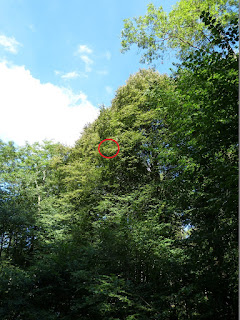The leafmines season is well under way, so apologies for the regular pics of leaves on the Blog (perhaps it will inspire a few more people to record mines). I'm making brief (10 minute) stops in far-flung bits of VC35 to try to boost Micro records, and it's good to get some records from September because several trees, especially Birch and Rowan, lose their leaves very early. The west still needs some concerted mining effort if anyone wants to try...
Anyway, this week my focus has been on Elm, which is abundant in many hedges in the north-east of Monmouthshire.
Phyllonorycter tristrigella (12 previous VC35 records) and
Stigmella lemniscella (10 records) are frequent, whereas
S. ulmivora (4 records) seems to be genuinely uncommon. Most
P. tristrigella mines are obviously long and narrow, but two rounder ones near Skenfrith got me hoping for
P. schreberella (4 previous records). I opened one up, and the larva inside was obviously pale green, so this was just
P. tristrigella after all.
This morning, a stop near the Hendre revealed more
P. tristrigella, followed by an underside mine that was more obviously circular from above as well as being broad below. Sure enough, this one held a yellow larva: the 5th Monmouthshire record for
P. schreberella.
The same length of hedgerow also held a short, vacated mine of
Bucculatrix albedinella, which has just two previous records.
Stigmella viscerella is my final Elm target: it has just three previous records and is clearly rare here.










































